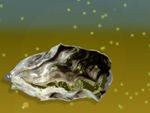Restoring New York’s Oysters
How volunteers and scientists are fighting an uphill battle to bring the mollusk back to the city’s waters.
Eric R. Olson • September 10, 2008
![Can oysters really make a come back in New York City's waters? [Photo by Eric R. Olson]](https://scienceline.org/wp-content/uploads/2008/09/oystertopimage.jpg)
Can oysters really make a come back in New York City's waters? [Photo by Eric R. Olson]
This lack of homegrown oysters hasn’t always been the case. The American oyster, Crassostrea virginica, once abounded in the waterways of New York. At one time there were close to 350 square miles (900 square kilometers) of oyster reefs in the area. Up until the early twentieth century, oysters were farmed on the shores of the East River, producing today’s equivalent of a $233 million annual trade.
Oysters were so abundant and readily available that they were sold as fast food in lower Manhattan. Mark Kurlansky writes in his book The Big Oyster: History on the Half Shell:
“It was not necessary to go to a market to find an oyster stand unless one was overtaken by the urge late at night. They were located throughout the city, as commonplace as hotdog stands today—street carts or dilapidated shacks with a window through which oysters were passed.”
But eventually overpopulation in New York led to an untenable situation for its oysters. In addition to the pressure of overfishing, the mollusks soon found themselves suffocating in the very things they like to eat: algae.
Like any other plants, algae need a nitrogen source to grow, and that’s exactly what raw sewage provides: a nitrogen-based chemical called nitrate that acts as a fertilizer. In 1910, there were roughly 600 million gallons (2.3 billion liters) of raw sewage flowing into New York waterways every year, creating massive algal blooms.
On its own, excess algae isn’t necessarily a bad thing. The problem is that this hyperactive growth of algae soon burns itself out, and the blooms begin to die off en masse. As they decompose, the tiny carcasses of the algae suck oxygen out of the water. This creates a state known as “environmental hypoxia,” or lack of oxygen. And because aquatic creatures need oxygen to breathe, everything soon croaks—including the oysters.
 Click here to see how oysters can clean up waterways. |
Losing oysters created a serious problem for the ecosystems in the Big Apple’s waterways. Aside from being a delicious snack for New Yorkers, oysters also provided a much more crucial service—keeping the water clean and clear. Oysters are masters of filtration, sifting sand, sediment and algae out of the water. A single adult oyster can siphon about one to two gallons of water (four to eight liters) per hour, which adds up to 24 to 48 gallons (96 to 192 liters) per day. Without this filtering, sunlight cannot penetrate to the sea floor, and the whole ecosystem that is dependent on the plants growing there collapses.
Besides spurring algae growth, raw sewage often contains infectious bacteria, which ultimately led to the demise of the New York oyster industry. In 1927, the New York City Health Department declared oysters unsafe to eat. The last oyster beds were closed due to a fear of infection by the Salmonella bacteria that cause typhoid fever.
3 Comments
Dear Eric,
Fantastic story! I’m going to show it to my colleagues here as an example of excellent writing and use of multimedia.
One correction–I don’t believe there was a 1963 World’s Fair–isn’t it the 1964 World’s Fair?
Ben Stein
SERP 9
Fascinating article. As a native New Yorker, it is mind-boggling to think that something alive and nourishing could possibly exist in those waters. Good luck to those environmental warriors!
Al Gore talks about the space between dismay and despair where we actually act to do something to change the situation. This is a good example of where lots of individual efforts make a difference.